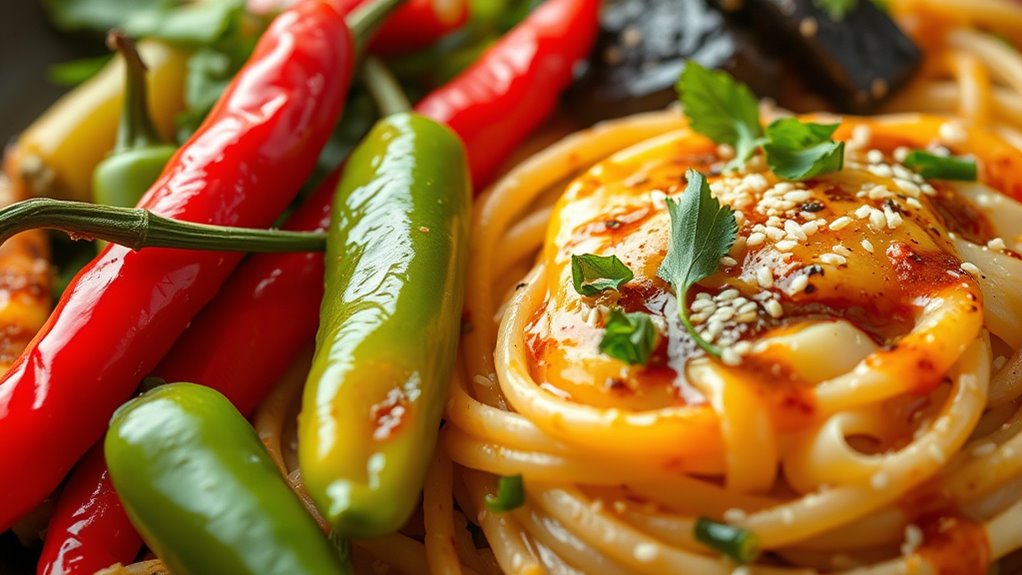Your preference for spicy or mild foods reflects your taste buds, cultural background, and personal experiences. If you enjoy heat, you probably grew up loving fiery dishes and seek out bold flavors, while those who prefer milder tastes value subtle seasonings and familiar comfort foods. Over time, your tolerance may have evolved based on exposure and health considerations. To explore deeper, discover how your cultural influences and culinary choices shape your flavor preferences.
Key Takeaways
- Personal taste buds and cultural background influence whether you prefer spicy or mild foods.
- Exposure and experience with different cuisines shape your tolerance and craving for heat over time.
- Spicy food enthusiasts tend to buy hot sauces and chili peppers, while mild flavor lovers prefer herbs like basil and parsley.
- Your spice preference affects your culinary choices, ingredient selection, and willingness to explore new flavors.
- Flavor preferences evolve personally and culturally, reflecting individual experiences, comfort levels, and health considerations.

Whether you prefer your food fiery and bold or gentle and subtle, your spice tolerance reflects your taste buds and cultural influences. Your flavor preferences shape how you approach culinary choices, guiding you toward dishes that satisfy your palate. Some people thrive on the heat of chili peppers and spices, seeking that adrenaline rush with every bite, while others prefer milder flavors that allow more delicate ingredients to shine. Your personal preference isn’t just about taste—it’s a reflection of your background, experiences, and even your health considerations. You might find yourself gravitating toward fiery cuisines like Indian or Mexican, where spices add depth and complexity, or sticking with milder dishes that highlight fresh herbs and subtle seasonings.
Your culinary choices are often influenced by what your taste buds have grown accustomed to. If you grew up eating spicy foods, your tolerance likely increased over time, and now you crave that boldness. Conversely, if you’ve always favored milder fare, your palate might shy away from heat, preferring comfort and familiarity. This preference impacts everything from the dishes you order at a restaurant to the ingredients you keep in your pantry. For instance, if spicy foods appeal to you, you might regularly buy hot sauce, chili powders, or fresh peppers to incorporate into your recipes. On the other hand, if you prefer milder flavors, you may lean toward herbs like basil, parsley, or thyme, emphasizing subtle seasoning to enhance natural ingredients.
Your choice between spicy and mild also influences your culinary experimentation. Spicy foods often challenge your tolerance and push your boundaries, encouraging you to try new cuisines and flavor combinations. Mild dishes, however, tend to be more versatile and accessible, making them ideal for family meals or when sharing food with others who might have different spice preferences. This diversity in culinary choices reflects your willingness to explore or to stick to what you know best. It’s not just about heat levels; it’s about how flavors combine and how those combinations align with your overall taste profile. Additionally, cultural influences play a significant role in shaping your spice preferences, as different cuisines prioritize varying levels of heat and seasoning.
Ultimately, your spice tolerance and flavor preferences are personal, evolving over time as you discover new dishes and ingredients. Whether you increasingly crave the fiery punch of chili-laden dishes or find comfort in the gentle embrace of subtle seasonings, your culinary choices reveal a lot about your tastes and cultural influences. Embracing your unique preference helps you craft meals that truly satisfy your cravings and make eating an enjoyable, personalized experience.
Frequently Asked Questions
How Does Spice Level Affect Digestion?
Your spice tolerance influences how your body reacts during digestion. Spicy foods can boost your metabolism and promote healthy digestion, but if you’re sensitive, they may cause digestive reactions like heartburn or stomach upset. When you eat spicy foods regularly, your body adapts, reducing negative reactions. However, if your spice tolerance is low, it’s best to enjoy milder dishes to prevent discomfort and support smooth digestion.
Are Spicy Foods Suitable for Sensitive Stomachs?
Sure, spicy foods are perfect for those with an adventurous spice tolerance—just don’t expect your sensitive stomach to join the flavor evolution. While some can handle heat with grace, others might find it more like a fiery rebellion. If your stomach’s delicate, it’s wise to approach spicy dishes cautiously, lest your digestive system stage a protest. After all, not everyone’s palate is ready for that fiery leap into culinary sophistication.
Can Taste Preferences Change Over Time?
Yes, your taste preferences can change over time due to taste evolution and flavor shifts. You might find yourself leaning toward milder dishes now if you once loved spicy foods, or vice versa. Factors like age, exposure to new cuisines, and changing health needs influence these shifts. Embracing these changes lets you explore new flavors and enjoy your meals more, reflecting your evolving palate naturally.
What Are the Health Benefits of Spicy Food?
Spicy food offers health benefits like boosting your metabolism and improving circulation. The capsaicin in peppers enhances flavor, making dishes more exciting and satisfying. It also aligns with many culinary traditions, adding depth and heat to meals. Eating spicy foods regularly may reduce inflammation and lower cholesterol. So, if you enjoy the heat, you’re not only savoring flavor but also supporting your overall health.
How Do Cultural Backgrounds Influence Spice Preferences?
Your cultural background greatly influences your spice preferences because it shapes your culinary traditions and flavor preferences. If you grow up in a culture that values bold, spicy dishes, you’re more likely to enjoy and seek out that exciting heat. Conversely, if your culinary traditions favor milder flavors, you might prefer less spice. Your cultural flavor experiences naturally guide your taste buds toward the level of spice that feels most authentic and satisfying to you.
Conclusion
So, whether you prefer your food fiery or gentle, your choice reflects your unique palate. Do you crave that adrenaline rush from spicy dishes or find comfort in milder flavors? Remember, there’s no right or wrong—only what satisfies your taste buds. Embrace your preference, experiment, and enjoy every bite. After all, food is about pleasure and personal expression. So, what’s your flavor of choice—spicy or mild?
Joy, as our Editor in Chief, ensures the highest standard of content. Her talent in writing is complemented by her attention to detail and passion for literature and culture. Joy’s expertise and love for the English language shine through in her editorial work, making each piece a testament to quality and clarity.










